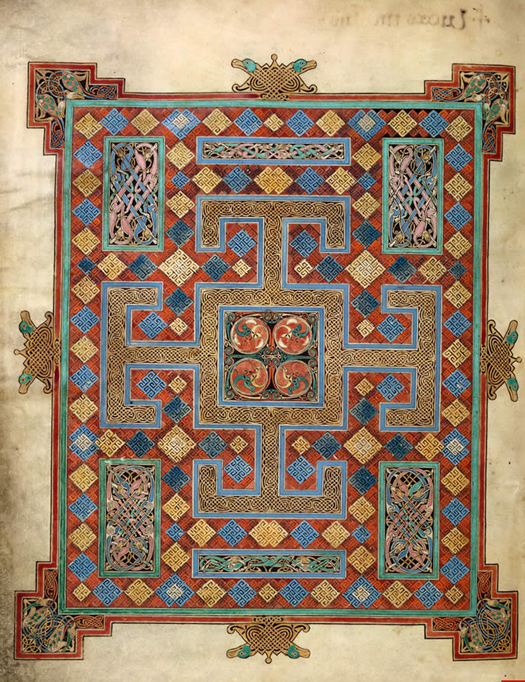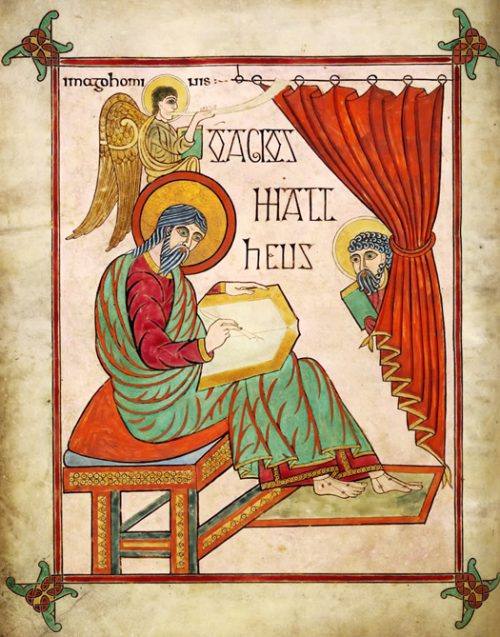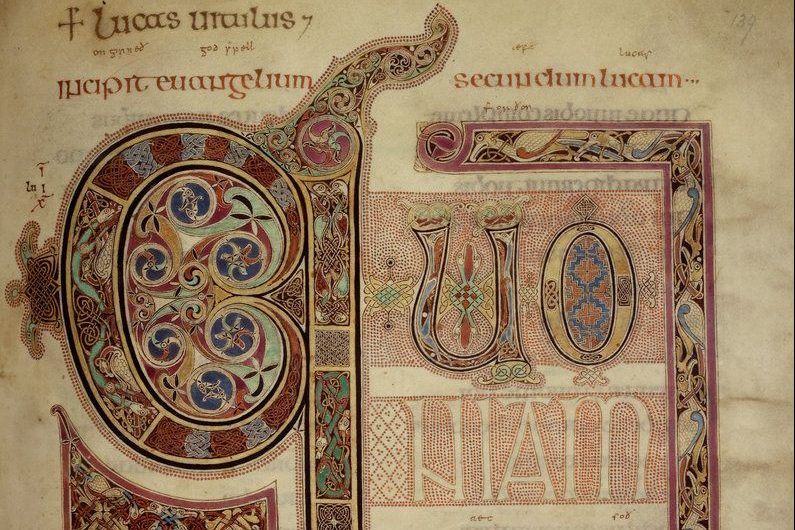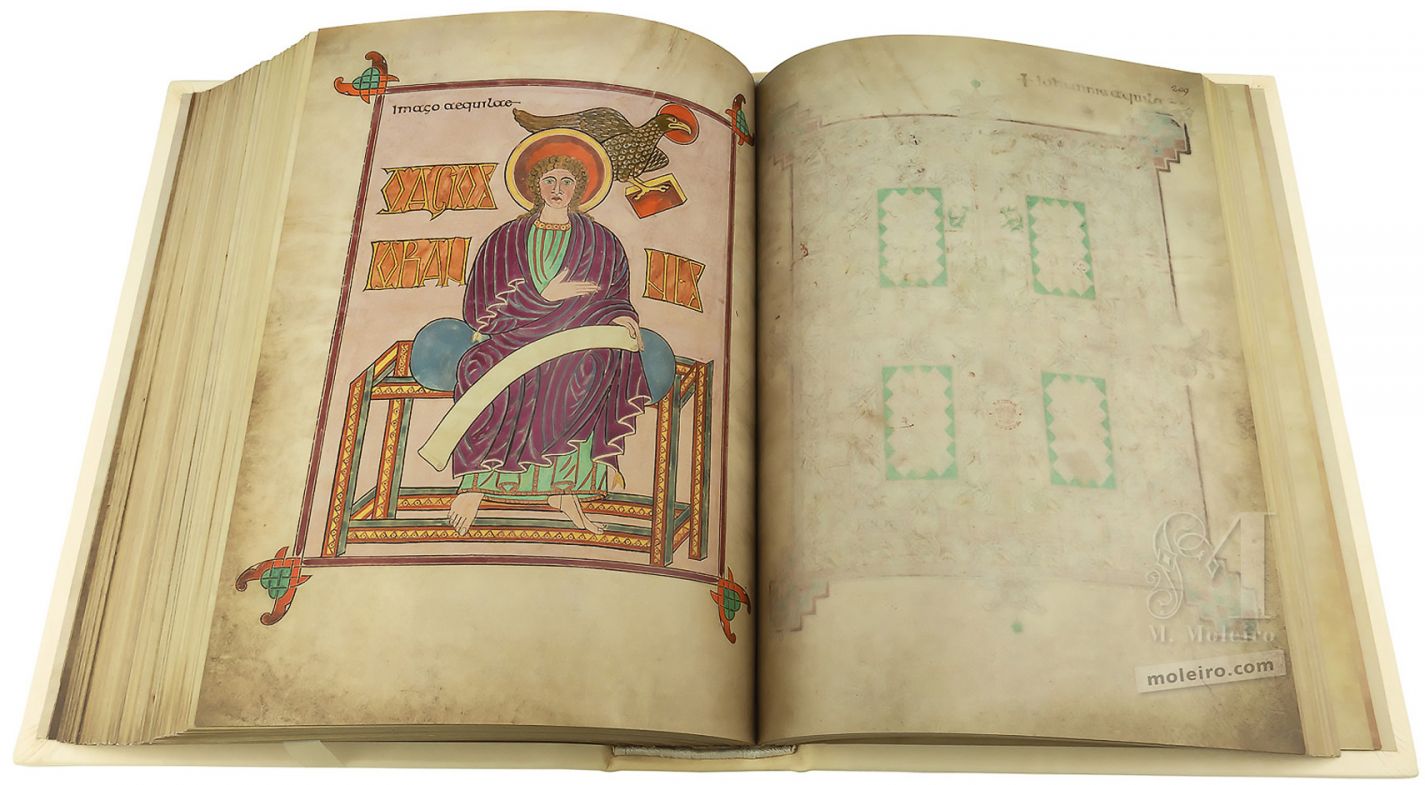Lindisfarne Gospels a 13centuryold Masterpiece

Evangelios de Lindisfarne La guía de Historia del Arte
Os Evangelhos de Lindisfarne são manuscritos feitos no final do século VII, início do século VIII, em Lindisfarne, na Nortúmbria. Evangelhos de Lindisfarne. Estas iluminuras incluem os Evangelhos de São Mateus, São Marcos, São Lucas e de São João. O Commons possui uma categoria com imagens e outros ficheiros sobre Evangelhos de.

Evangelio de Lindisfarne Anglo saxon, Saxon, Gospel of luke
The Lindisfarne Gospels (London, British Library Cotton MS Nero D.IV) is an illuminated manuscript gospel book probably produced around the years 715-720 in the monastery at Lindisfarne, off the coast of Northumberland, which is now in the British Library in London. [1] The manuscript is one of the finest works in the unique style of Hiberno.

Lindisfarne Gospels (Illustration) Ancient History Encyclopedia
Lindisfarne - also known as Holy Island - is one of the most important centres of early English Christianity. Irish monks settled here in AD 635 and the monastery became the centre of a major saint's cult celebrating its bishop, Cuthbert. The masterpiece now known as the Lindisfarne Gospels was created here in the early 8th century. The.

Evangelios de Lindisfarne La guía de Historia del Arte
The Lindisfarne Gospels. A medieval monk takes up a quill pen, fashioned from a goose feather, and dips it into a rich, black ink made from soot. Seated on a wooden chair in the scriptorium of Lindisfarne, an island off the coast of Northumberland in England, he stares hard at the words from a manuscript made in Italy.

Lindisfarne Gospels St Mark f. 93v Illuminated manuscript, Medieval
Os Evangelhos, que podem ter levado dez anos para serem concluídos, foram a obra de uma pessoa apenas. Acredita-se que ela tenha sido Eadfrith, um monge que se tornou bispo por volta de 698, um cargo que ele ocupou até 722, sendo a ele creditado o trabalho em uma nota — conhecida como colofão —, a qual foi adicionada por um padre chamado Aldred, no final do Século X.

Lindisfarne Gospels Facsimile — A. P. Manuscripts
De facto, os Evangelhos de Lindisfarne são o manuscrito insular mais completo conservado. Foi concebido entre os anos de 687 e 721, por e para a comunidade religiosa do mosteiro na ilha de Lindisfarne, famosa por ter sido atacada pelos Vikings em 8 de Junho de 793, efeméride que é considerada o início da Era Viking..

Evangelios de Lindisfarne La guía de Historia del Arte
The Lindisfarne Gospels is now on exhibition at the British Library showing the Chi-rho page, a particularly appropriate display for Christmastime. The Chi-rho is the abbreviated Greek name of Christ, spelled Chi-rho-iota, or 'XPI'.In some early Latin gospel-books, including the Lindisfarne Gospels, there is a large decorated Chi-rho at the beginning of the account of the Incarnation at.

L’évangéliaire de Lindisfarne Par la foi
Lindisfarne Gospels, John's cross-carpet page, folio 210v. (British Library) The book is a spectacular example of Insular or Hiberno-Saxon art—works produced in the British Isles between 500-900 C.E., a time of devastating invasions and political upheavals. Monks read from it during rituals at their Lindisfarne Priory on Holy Island, a.

The Lindisfarne Gospels, is one of the great masterpieces of medieval
This category is located at Category:Lindisfarne Gospels (710-721) - BL Cotton MS Nero D IV. Note: This category should be empty. Any content should be recategorised. This tag should be used on existing categories that are likely to be used by others, even though the "real" category is elsewhere.

EVANGELIOS DE LINDISFARNE EADERITH ARTE DE VARIOS PAÍSES
The Lindisfarne Gospels. The Lindisfarne Gospels, a treasure at The British Library, is an illuminated manuscript featuring stunning carpet pages and intricate designs. Created on the island of Lindisfarne, it showcases a fusion of Irish Christian and Roman influences. The manuscript contains the four Gospels, each with a unique carpet page and.

Lindisfarne Gospels Facsimile — A. P. Manuscripts
Lindisfarne Gospels, manuscript (MS. Cotton Nero D.IV.; British Museum, London) illuminated in the late 7th or 8th century in the Hiberno-Saxon style. The book was probably made for Eadfrith, the bishop of Lindisfarne from 698 to 721. Attributed to the Northumbrian school, the Lindisfarne Gospels

Lindisfarne Gospels, Saint Matthew crosscarpet, page 9, Hiberno Saxon
The Lindisfarne Gospelsor the Book of Lindisfarne (British Library Cotton MS Nero D.IV), is an illuminated manuscript of the four Gospels from the New Testament of the Bible. The manuscript was produced in Lindisfarne Priory on Holy Island (formerly called Lindisfarne Island), off the coast of Northumberland in about 715 C.E, largely the work of a single man between 715 and 720.

Lindisfarne Gospels St John f. 209v British Library Early AngloSaxon
Category: Lindisfarne Gospels (710-721) - BL Cotton MS Nero D IV. From Wikimedia Commons, the free media repository.. Biblioteca Nacional de España ID: XX4583074 NORAF ID: 90325719 PLWABN ID: 9810653023005606 National Library of Israel J9U ID: 987007264668205171. Reasonator; Scholia; Wikidocumentaries;

Evangelhos de Lindisfarne
The writing room Aidan's monks established, a scriptorium, paved the way for the creation of the Lindisfarne Gospels a generation later, but its production is linked to another famous event in.

The Lindisfarne Gospels is an illuminated Latin manuscript of the
Evangelhos de Lindisfarne. Os Evangelhos de Lindisfarne são manuscritos feitos no final do século VII, início do século VIII, em Lindisfarne, na Nortúmbria . Estas iluminuras incluem os Evangelhos de São Mateus, São Marcos, São Lucas e de São João . O Commons possui uma categoria com imagens e outros ficheiros sobre Evangelhos de.

Lindisfarne Gospels Gospel of St Luke f. 143v Lindisfarne gospels
E adfrith, according to a 10th-century inscription, was a monk and Bishop of Lindisfarne on Northumbria's Holy Island, who wrote out and illuminated the entire gospels singlehandedly, to create.